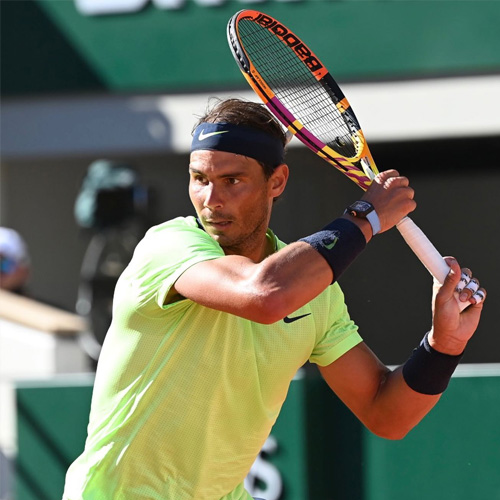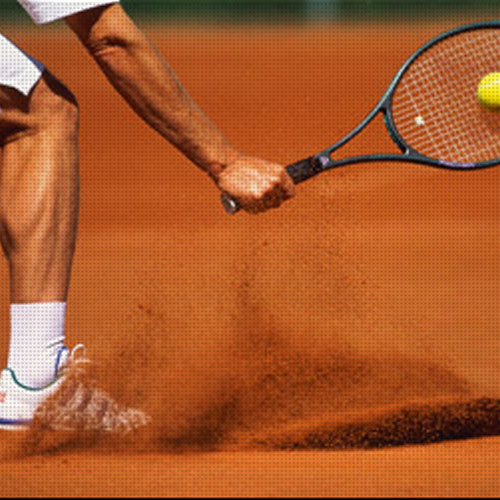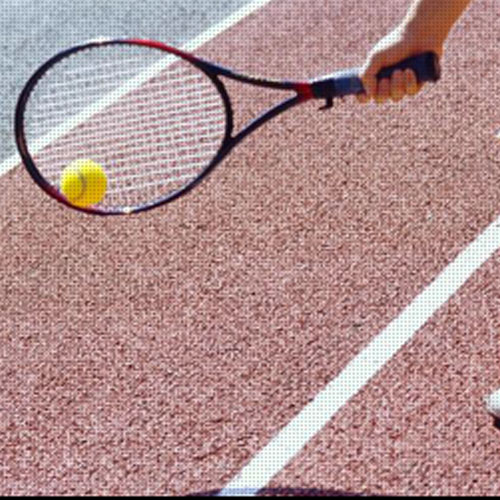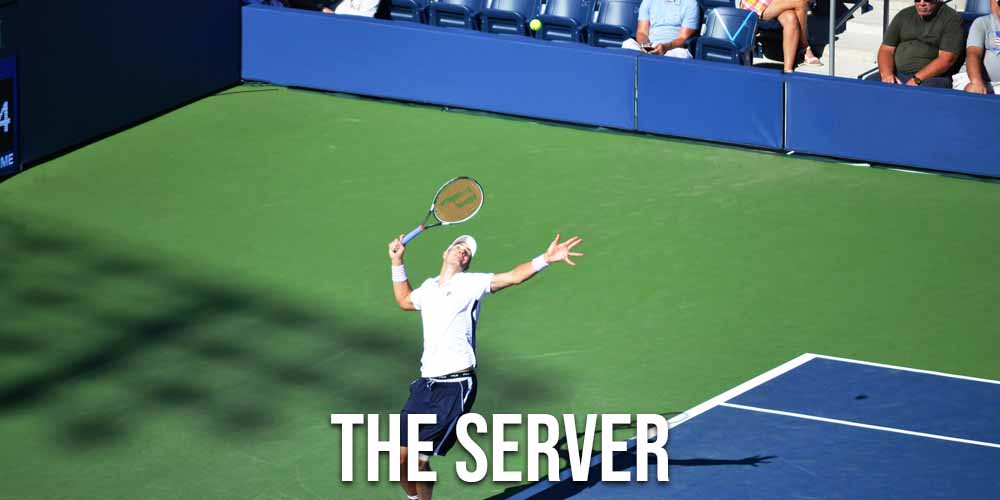The way a player hits the ball is known as their technique.There are many techniquesand not all players use the same ones. There are, however, some common points which ensure good basic techniques.
GRIPS
The way a player hits the ball is known as their technique. There are many techniques and not all players use the same ones. There are, however, some common points which ensure good basic techniques.

EASTERN FOREHAND
“This is known as the ‘shake hands’ grip because the palm is placed behind the handle and the thumb is wrapped round the grip as though ‘shaking hand’ with the racket. The index finger is slightly spread apart from the middle finger. This grip is good for the forehand drive allowing you to hit balls of different heights with good strength. In addition, it can be used for the forehand volley, the lob and, for beginners, their first steps in serving.”

SEMI-WESTERN FOREHAND
“This grip is used mainly for the forehand drive. The palm lies more underneath the handle. This grip makes it easier to hit balls that are above waist height, and leads to aggressive forehand shots.”

EASTERN BACKHAND
“This is an effective grip used for the backhand drive (see pages39and 41).Often players wrap their thumb around the black. This is a very sensitive and strong grip.”

TWO-HANDED BACKHAND
“The two-handed backhand provides greater strength and control for beginners then a one-handed backhand. Both hands should be close together and touching each other on the handle without overlapping. Junior beginners may choose to hold the racket using an Eastern forehand grip for both hands. More able player should alter this as soon as they can for more power and control. The hand nearest the end of the racket should use a continental, or if physically stronger, an Eastern backhand, grip. The added hand should employ an Eastern forehand grip.”

CHOPPER OR CONTINENTAL
The chopper grip is used mainly for the service and for advanced stages of the volley. It is halfway between the Eastern forehand and backhand, and involves placing the palm of the hand on top of the racket for the service, similar to how you might hold a hammer. It provides greater racket head speed, flexibility and variation for the serve than the straightforward forehand grip.
Basic strokes for beginners
Many different factors go into how well a player hits the ball. Some of these happen before the ball has even bounced. The essentials of good technique are described below in the order that they happen on the court.
Grounds strokes


READING THE BALL
Quick forwards, backwards and sideways movement is absolutely vital in tennis. But getting quickly into the right position and staying balanced is not just to do with footwork. The better that a player can ‘read’ the ball, the quicker they will be able to move into the correct position.
To do this ,players need to be aware of the different flight paths of the ball in tennis and to be able to recognize them as the ball travels towards them. Factors which affect the flight path of the ball include:
- THE SPEED WITH WHICH THE BALL IS HIT
- THE POSITION ON THE COURT FROM WHERE IT WAS HIT
- THE SPIN USED BY THEIR OPPONENT
- THE COURT SURFACE
- THE COURT SURFACE
- THE HEIGHT OF THE SHOT
Players have to read and predict the depth of an incoming shot. For example, a softly hit shot with no spin will land shorter in the court. They must also be able to calculate the likely bounce. For example, a high loopy flight path is likely to result in a high bounce whilst a hard and low flight path is likely to result in a fast, low bounce.
Beginners often run to where the ball is going to bounce, instead of to where the ball will be at the right height to hit after the bounce. This skill tends to improve with experience. Top players seem to know where the ball is going and appear to be waiting for it to arrive. This seemingly effortless skill is the result of great experience and many hours of hard work and practice
Movement and Balance
Whether you have good technique or merely want to get on with playing the game casually, coordinating the racket swing to the ball is often the biggest challenge. It requires good footwork and balance. In a rally the opponent will move the ball around the react to and read the incoming ball. The aim is to move into a position for a good contact point (see below) with the ball whilst keeping your balance throughout the shot.
Tennis is a fast-moving game so it is not always possible to be in perfect position. But you can move your feet to get into an approximate position quickly and then make smaller adjustment to your footwork so that you can get balanced and in the best possible position movement before slowing down to gain balance just before the ball arrives.
To judge how good your footwork and balance is, be aware of work and balance after you hit the ball. If you were balanced after the hit it is likely you were in control of the ball. If you are making recovery steps to get back on balance immediately after the hit, then it is likely that the after hit, then is likely that the ball was in control of you!
STANCE
Stance refers to the position of the body the feet as the ball comes towards you. For beginners, being sideway to the ball on both forehand and backhand strokes is advisable. This allows for a basic swing part to be developed more easily. As a player gets better, the shoulders will always turn sideways to the ball as part of their shot preparation.
CONTACT POINT
Where you hit the ball in relation to your body is known as the ‘contact point’. The position of the contact in relation to the body is pinpointed by three dimensions:
- THE HEIGHT OF THE CONTACT IN RELATION TO YOUR BODY
- THE DISTANCE OF THE CONTACT FROM YOUR BODY TO THE SIDE
- THE DISTANCE OF THE CONTACT FROM YOUR BODY IN FRONT/BEHIND
- Generally speaking, the contact point should be comfortably in front of your body and comfortably to the side.
Double-Handed Backhand

HEIGHT OF CONTACT POINT
The height of the contact point can vary depending on:
- THE GRIP USED
- THE HEIGHT OF THE INCOMING BALL
- THE TACTICAL INTENTION
- THE STANDARD OF PLAYER
To give some examples, a first serve will not bounce as height as a groundstroke whilst a ball bounces higher on hard courts than on artificial grass courts. Attacking shots are better taken above net height whilst a player with a semi-Western grip will be able to contact a higher ball more comfortably than a player with an Eastern grip.
The easiest time for beginners to contact the ball is ball is after the ball has reached the top of its bounce (the highest point ) and is just beginning to fall towards what would be its second bounce.
ACTION
The ‘action’ is as vital asthe contact point. The racket travel through the ball. Beginners often ‘push’ the ball in to play because they dont want to let the racket get too far away from the imagined contact point in case they miss it when it arrives. However, for greater power, the racket should be swung at the ball, building up speed to the contact point and folllowing through after heigher than the contact.
The path that the racket travels is known as the ‘swing path’. Statrting from the ready position, the swing paths are broken down into the ‘take back’ and the ‘follow through’. In simple terms:
- THE TAKE BACK INVOLVES TAKING THE RACKET BACK EARLY WHILST TURNING THE SHOULDERS SO THAT THE BALL CAN BE PLAYED FROM THE SIDE
- THE FOLLOW THROUGH FOR GROUNDSTROKES IS FROMLOW THROUGH THE CONTACT POINT TO HIGHWITH THE RACKET TRAVELLING ABOVE THE BALL AFTER THE CONTACT.

BAT AND BALL
During the swing, control of the angle of the racket face is vital. Tennis is a bat and ball’ game. The ball will end up where the strings face at the contact point. Players described as having great ‘touch ‘display great control of the racket face.
Spin

Many players apply spin to the ball. The two most common types are topspin and slice. Topspin makes the ball rotate forward, and slice(or backspin)makes the ball rotate backwards, as it travels .Spin is added because it may be essential on same court surfaces or a vital part of a player’s tactics. It may also be used in rallies to confuse4 an opponent and upset their rhythm.
LIFTED GROUNDSTROKE

The ball rotates forward slightly as it flies and bounces in a regular manner.
TOPSPIN GROUNDSTROKE
The ball rotates forwards as it flies. Its arc is a little higher and it will dip down at the end of its flight. It will generally bounce higher than the lifted groundstroke.
WHAT DOES SPIN DO?
Adding spin to a shot affects the following:
- THE ROTATION OF THE BALL
- THE BALL’S FLIGHT PATH THROUGH THE AIR
- THE BOUNCE OF THE BALL
- THE FLIGHT OF THE BALL AFTER THE BOUNCE
The Server

The action of a is essentially a throwing action. The strength of a player’s serve is closely related to the strength of their throw.The serve is the one shot in tennis that you are in total control of, so don’t waste this opportunity. Pay close attention to building and grooving your service. Regular serving. Regular serving practice will help build your skills and confidence.
GRIP
Some beginners prefer to practice the serve using the Eastern the forehand grip. As they become more skilled, They can then adopt the chopper grip is the most effective grip for developing sin and power when serving.
STANCE
The starting position is a comfortable sideways position, with your feet shoulder-width apart. Maintaining good balance throughout, throw the air at a comfortable height and slightly towards your target. With practice, you will be able to work both hands together in rhythm. Try to feel a smooth, coordinated action. All the different parts of your body should be working together not fighting against each other.
Tip:- DON’T RUSH INTO THE SERVE, SPEND TIME GETTING YOUR STANCE RIGHT AND FOCUS ON WHERE YOU WANT TO AIM YOUR SERVE
Forehand volley

The forehand volley is a shot played before the ball has bounced on your side of the court. It is most used when a player is approaching or at the net, although, It is sometimes used in the midcourt or even deeper.
GRIP
Beginners often use the Eastern forehand grip at first. They are advised, though, to move on to the chopper grip which can make low volleying easier. The chopper grip can be used for either the forehand or the backhand volley, Which is particularly useful when there is not enough useful when there is not enough time to change the grip.
CONTACT POINT
As with the backhand volley, the contact should be in front, a comfortable distance to the side and ideally above net height. In reality, though, this will depend on the incoming ball.
ACTION
The volley has the simplest and shortest action of all major strokes. The racket path is from above the height of the ball forwards to below the height of the ball. The action is very short, a little like taking a one handed catch. The angle of the racket face at the point of contact is very important.
PRACTISING VOLLEYS
PRACTICE VOLLEYING FROM A POSITION CLOSE TO BUT NOT RIGHT NEXT TO THE NET-ABOUT A THIRD OF THE WAY BACK TO THE SERVICE LINE (THE FIRST LINE YOU SEE BEHIND YOU).ASK ANOTHER PLAYER TO HIT SHOTS WHICH REACH YOU AT AROUND OR JUST BELOW SHOULDER HEIGHT
